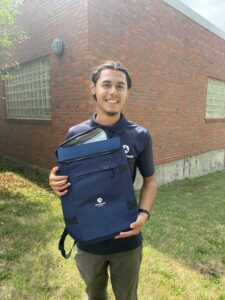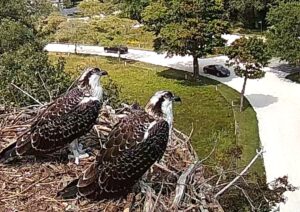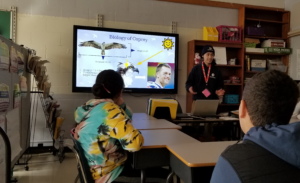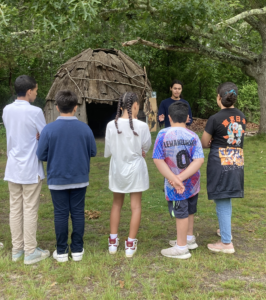(by Leonel Lainez, AmeriCorps Cape Cod)
 At the beginning of my AmeriCorps Cape Cod journey back in September, I was assigned to work with Joan Muller, the Education Coordinator from Waquoit Bay National Estuarine Research Reserve, and Nancy Church, a board member from the Friends of Mashpee Wildlife Refuge. Together, we were tasked with developing an educational program about Ospreys using a live webcam on the WBNERR campus. As a Person of Color, and Spanish being my first language, I noticed a struggle that no one could see.
At the beginning of my AmeriCorps Cape Cod journey back in September, I was assigned to work with Joan Muller, the Education Coordinator from Waquoit Bay National Estuarine Research Reserve, and Nancy Church, a board member from the Friends of Mashpee Wildlife Refuge. Together, we were tasked with developing an educational program about Ospreys using a live webcam on the WBNERR campus. As a Person of Color, and Spanish being my first language, I noticed a struggle that no one could see.
During a Pond Study with Joan Muller from Waquoit Bay National Estuarine Research Reserve, I conducted a shoreline survey around the pond. I noticed that the students who were not proficient in English or did not have English as their first language refrained from speaking up. This experience inspired me to create a citizen project for English Learning Developing students (ELD) to help them feel more comfortable and confident in their abilities to participate. In January, I reached out to Carmela Mayeski, a Learning Partnership Specialist for Falmouth Public Schools, for guidance on which schools to contact, teacher referrals, and student demographics. With her help, I connected with Christine Nicholson, the Head of the English Department in Falmouth, Melissa Crime an ELD teacher from Lawrence, and Mary Beth Knox, an ELD teacher from Morse Pond.
 After learning that Ospreys migrated to the Cape from South America, I saw a connection between the students to their homelands through the sea hawk. In February, I coordinated a meeting with Joan Muller, Nancy Church, and Alan F Poole, a well-known Osprey Biologist from the Cape, to discuss ways to make this project interactive for the students. Alan F Poole helped to create a structure of a citizen scientist project for the students to observe the Ospreys using a live webcam on a nest at WBNERR.
After learning that Ospreys migrated to the Cape from South America, I saw a connection between the students to their homelands through the sea hawk. In February, I coordinated a meeting with Joan Muller, Nancy Church, and Alan F Poole, a well-known Osprey Biologist from the Cape, to discuss ways to make this project interactive for the students. Alan F Poole helped to create a structure of a citizen scientist project for the students to observe the Ospreys using a live webcam on a nest at WBNERR.
In March, I presented to Melissa Crim and Mary Beth Knox ELD classrooms to prepare them for the project and provide some basic biology of Ospreys, right before the hawks migrated from South America so the students could see their arrival. The students from both classes were excited and eager to learn more about Ospreys and excited for their arrival in late March. Both teachers dedicated time in their classes to observe the ospreys and write down any observations or behaviors and will continue to do so until the end of the school year.
In between, I visited the schools again to provide another presentation and to see what the students were observing and how they were doing.  This presentation focused on the Adaptation and Behaviors of Ospreys; a continuation of the presentation given in March. In June, both classes joined me at WBNERR for a field day and a tour of the campus. I facilitated activities such as the Life of Osprey, an interactive board game that highlights Osprey’s different life stages, migration, and behavior. We also played our DDT Game, in which students picked up popsicle sticks that represent fish. Some of the fish are contaminated with DDT, and this helped illustrate the food chain of Osprey. We looked at the Ospreys the students were observing through binoculars and spotting scopes. This was the most exciting moment of the day because the students got to see the Osprey in person and witness them flying around campus.
This presentation focused on the Adaptation and Behaviors of Ospreys; a continuation of the presentation given in March. In June, both classes joined me at WBNERR for a field day and a tour of the campus. I facilitated activities such as the Life of Osprey, an interactive board game that highlights Osprey’s different life stages, migration, and behavior. We also played our DDT Game, in which students picked up popsicle sticks that represent fish. Some of the fish are contaminated with DDT, and this helped illustrate the food chain of Osprey. We looked at the Ospreys the students were observing through binoculars and spotting scopes. This was the most exciting moment of the day because the students got to see the Osprey in person and witness them flying around campus.

Overall, this project was a great success. It not only helped ELD students feel more comfortable participating in class, but it also provided a valuable learning experience for all the students involved. Through this project, they were able to connect with nature and learn about the migration patterns and behaviors of Ospreys. I am grateful for the opportunity to have worked on this project and for the support and guidance from all the individuals involved.
